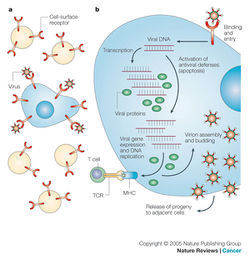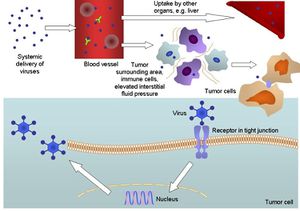Using Oncolytic Viruses to Treat Cancer: Difference between revisions
m (→Viruses Used) |
|||
| Line 18: | Line 18: | ||
==Viruses Used== | ==Viruses Used== | ||
Adenovirus | <u>Adenovirus</u> | ||
Adenoviruses can be constructed to cause cancer cells to lyse because the cell is overwhelmed by the replicating virus. The virus can also inject DNA into the cancer to produce cytotoxic proteins that help to either deactivate the cancer or cause the cancer to become more sensitive to the chemotherapy and radiation. [1] | Adenoviruses can be constructed to cause cancer cells to lyse because the cell is overwhelmed by the replicating virus. The virus can also inject DNA into the cancer to produce cytotoxic proteins that help to either deactivate the cancer or cause the cancer to become more sensitive to the chemotherapy and radiation. [1] | ||
Herpes Simplex | |||
<u>Herpes Simplex</u> | |||
Like adenoviruses, herpes simplex viruses can be made to cause tumor cells to lyse and to become more sensitive to the other cancer treatment methods. | Like adenoviruses, herpes simplex viruses can be made to cause tumor cells to lyse and to become more sensitive to the other cancer treatment methods. | ||
Vaccinia | |||
<u>Vaccinia</u> | |||
Vaccinia virus are also used to to produce negative tumor effects using transgene expression. | Vaccinia virus are also used to to produce negative tumor effects using transgene expression. | ||
<u>Reoviruses</u> | |||
Reoviruses | |||
Newcastle Disease Virus | <u>Newcastle Disease Virus</u> | ||
[[Image:AntitumorImmunity.jpg|thumb|200px|left|David L Bartlett, Zuqiang Liu, Magesh Sathaiah, Roshni Ravindranathan, Zongbi Guo, Yukai He and Zong Sheng Guo http://www.molecular-cancer.com/content/12/1/103]] | [[Image:AntitumorImmunity.jpg|thumb|200px|left|David L Bartlett, Zuqiang Liu, Magesh Sathaiah, Roshni Ravindranathan, Zongbi Guo, Yukai He and Zong Sheng Guo http://www.molecular-cancer.com/content/12/1/103]] | ||
Revision as of 02:45, 8 November 2013
Introduction
For many years, scientists have desired a method to augment the chemotherapy and radiation therapy currently utilized to aid in cancer therapy. However, many negative outcomes of the radiation and chemotherapy may include toxicity to both normal and cancer cells. Oncolytic viruses, however, have been shown to increase the positive therapeutic effects while also only targeting cancer cells and leaving the other cells intact. [1]

Methods
Direct Treatment
Direct Treatment utilizes oncolytic viruses either with or without regular chemotherapy, radiation, and indirect treatment. [1]
Indirect Treatment
Indirect Treatment involves manipulating the anti-tumor immunity of cells and using the viruses to facilitate an immune response within the body. [1]
Viruses Used
Adenovirus
Adenoviruses can be constructed to cause cancer cells to lyse because the cell is overwhelmed by the replicating virus. The virus can also inject DNA into the cancer to produce cytotoxic proteins that help to either deactivate the cancer or cause the cancer to become more sensitive to the chemotherapy and radiation. [1]
Herpes Simplex
Like adenoviruses, herpes simplex viruses can be made to cause tumor cells to lyse and to become more sensitive to the other cancer treatment methods.
Vaccinia
Vaccinia virus are also used to to produce negative tumor effects using transgene expression.
Reoviruses
Newcastle Disease Virus

Early History and Research
In the early 1900s, doctors noticed that patients who had both tumors and a rabies vaccine displayed tumor regression. They also noticed tumor regression with patients who displayed virus like symptoms and who had cancer. Researchers noted these correlations and, in the 1920s, found that influenza and newcastle disease viruses were able to infect and lyse certain mouse cancers. [1]
In the mid 1900s, human studies of wild adenovirus injected into cervical cancers showed some early regression, but eventually led to progression of the cancer; this led to a major decrease in oncolytic virus research. Current theories of the cause of these include limited understanding of virology, molecular biology, and cancer treatment.
Originally, oncolytic viruses were thought to be impaired by the immune system. Later advances showed that oncolytic viruses can specifically target the tumor cells so that human cells would not be harmed. [2]
Current Research
Currently, researchers are studying how to better target tumors by deleting viral genes that allow for attachment on non-cancerous cells. Research is also being conducted on how to further optimize the viruses to utilize the uncontrolled replication of cancerous cells to better destroy the cancerous cell. This, in conjunction with optimization of viral replication genes in the viruses has shown a greater than 50% survival rates in trials.

References
[1] Mullen, J. T. "Viral Oncolysis." The Oncologist 7.2 (2002): 106-19. Print.
[2] Pol, Jonathan G., Julien Resseguier, and Brian D. Lichty. "Oncolytic Viruses: A Step into Cancer Immunotherapy." Virus Adaptation and Treatment (2012): 1-21. Dovepress. Web. 7 Nov. 2013.
[3] Bartlett et al.: Oncolytic viruses as therapeutic cancer vaccines. Molecular Cancer 2013 12:103.
[4] Manish R. Patel, Robert A. Kratzke, Oncolytic virus therapy for cancer: the first wave of translational clinical trials, Translational Research, Volume 161, Issue 4, April 2013, Pages 355-364, ISSN 1931-5244, http://dx.doi.org/10.1016/j.trsl.2012.12.010.
[5] Wong, Han Hsi, Nicholas R. Lemoine, and Yaohe Wang. "Oncolytic Viruses for Cancer Therapy: Overcoming the Obstacles." Viruses 2.1 (2010): 78-106. Print.
